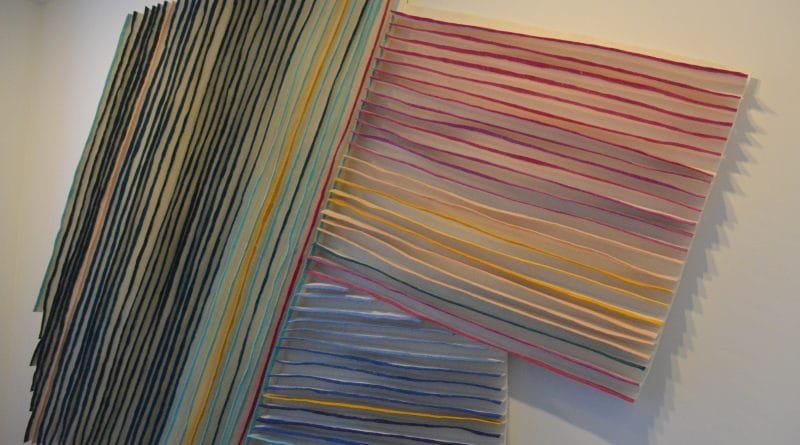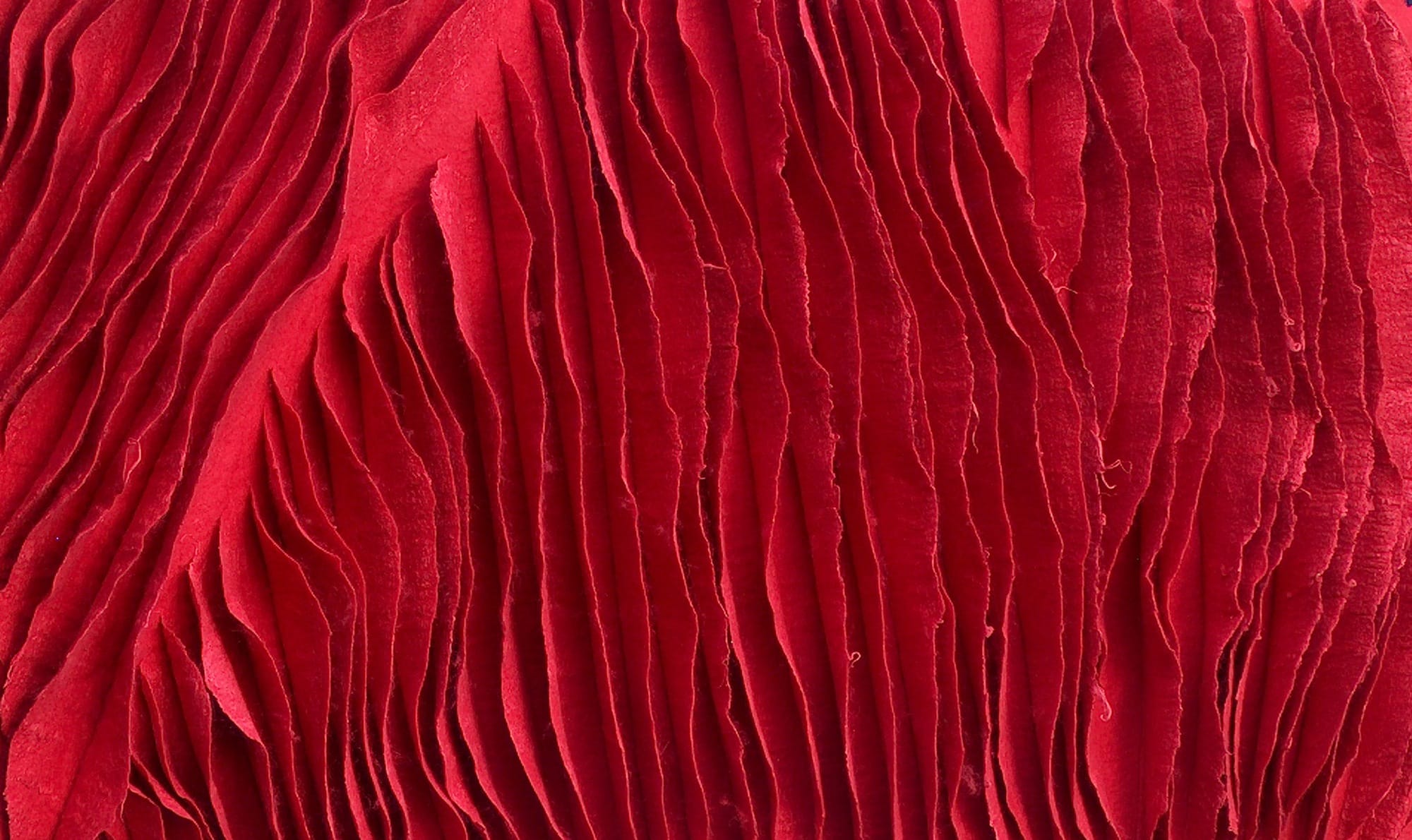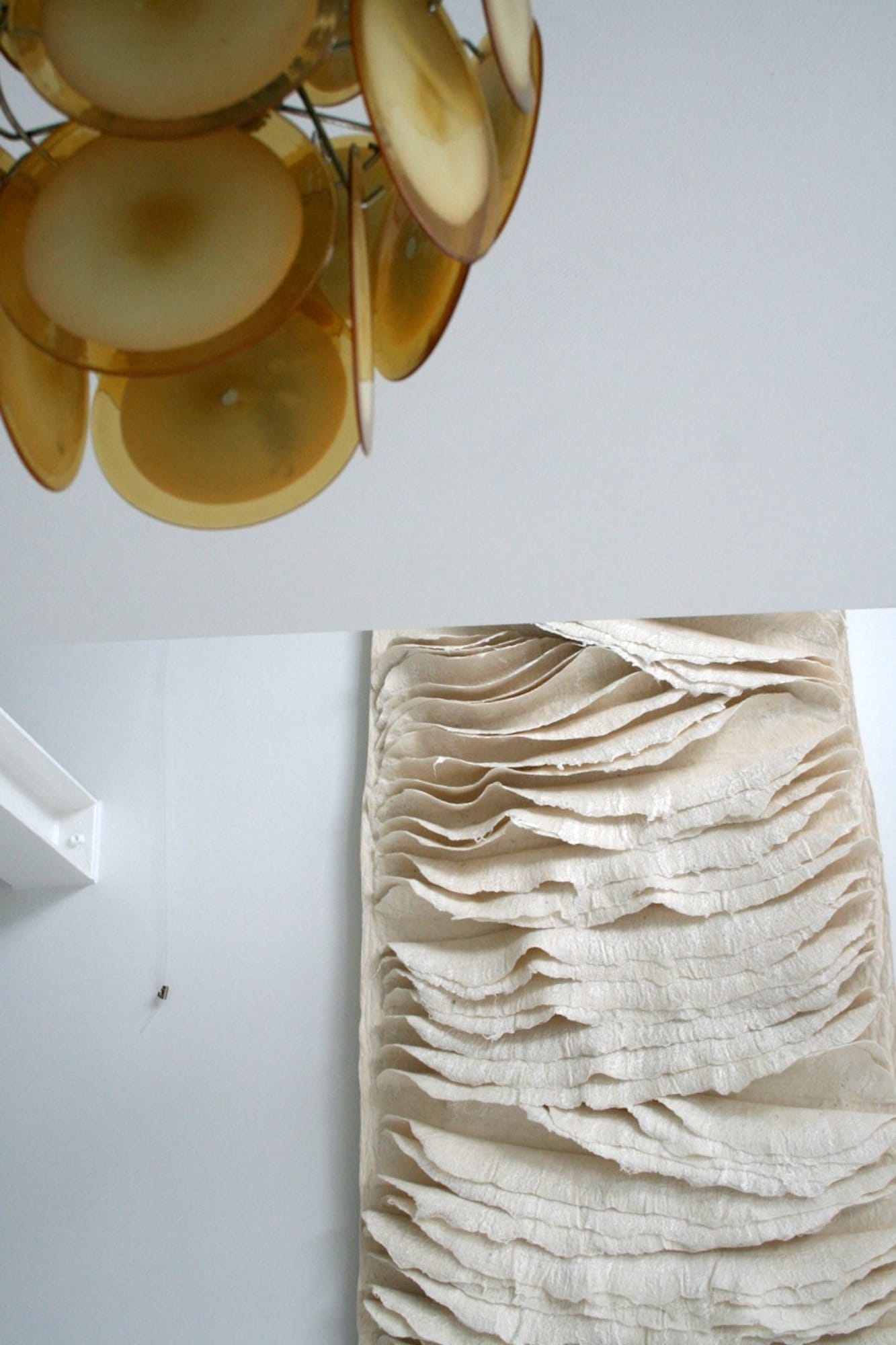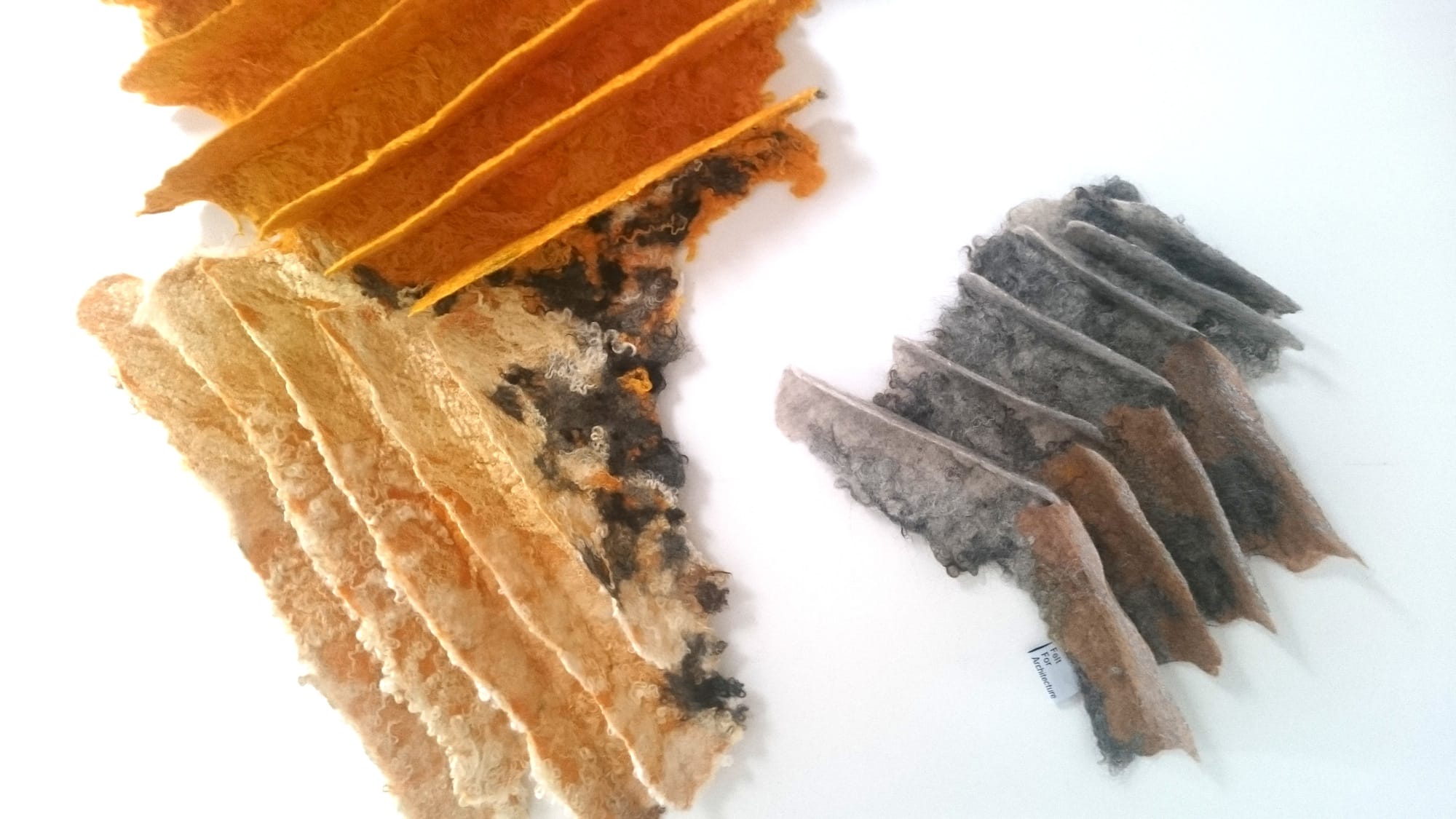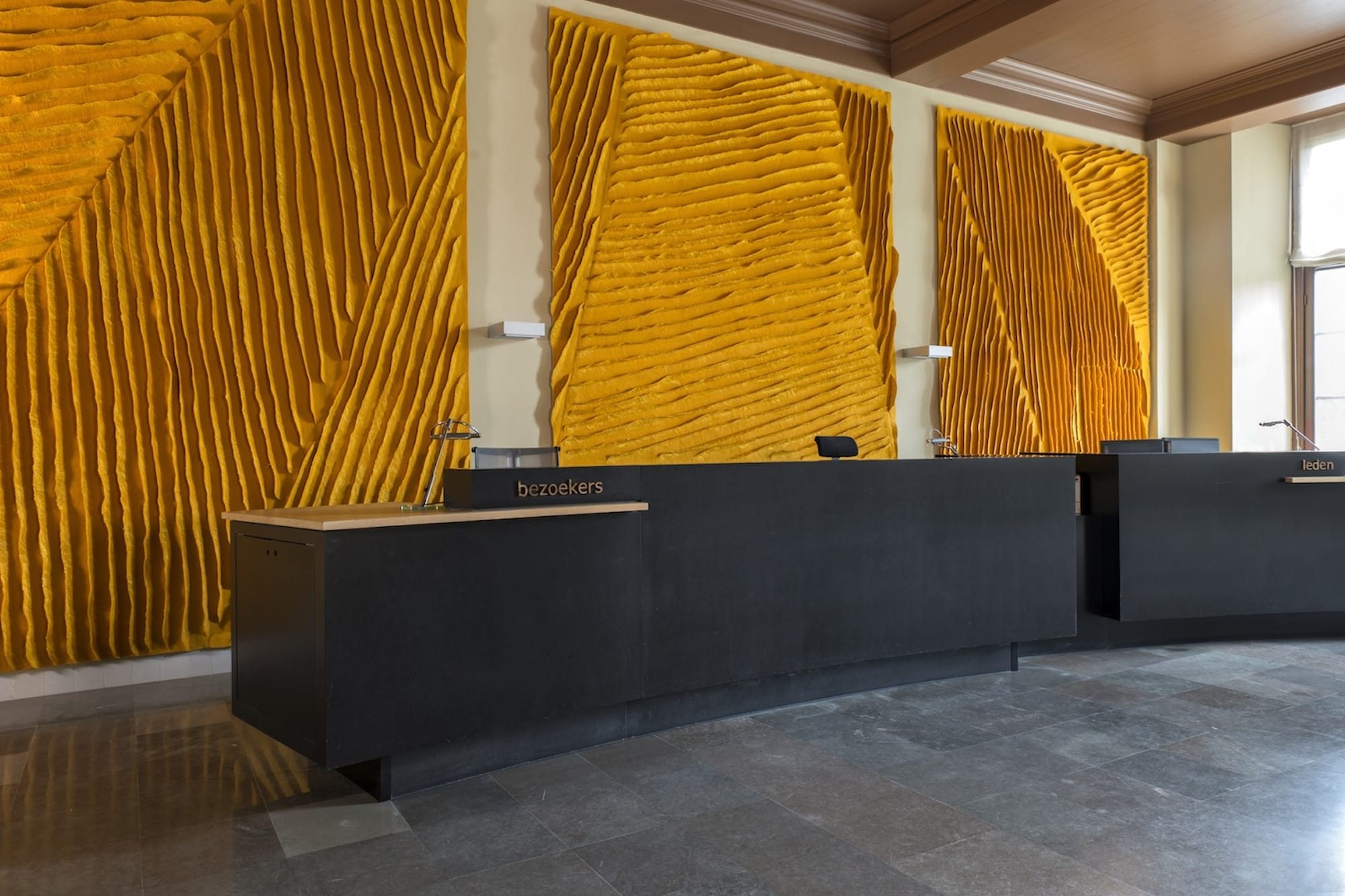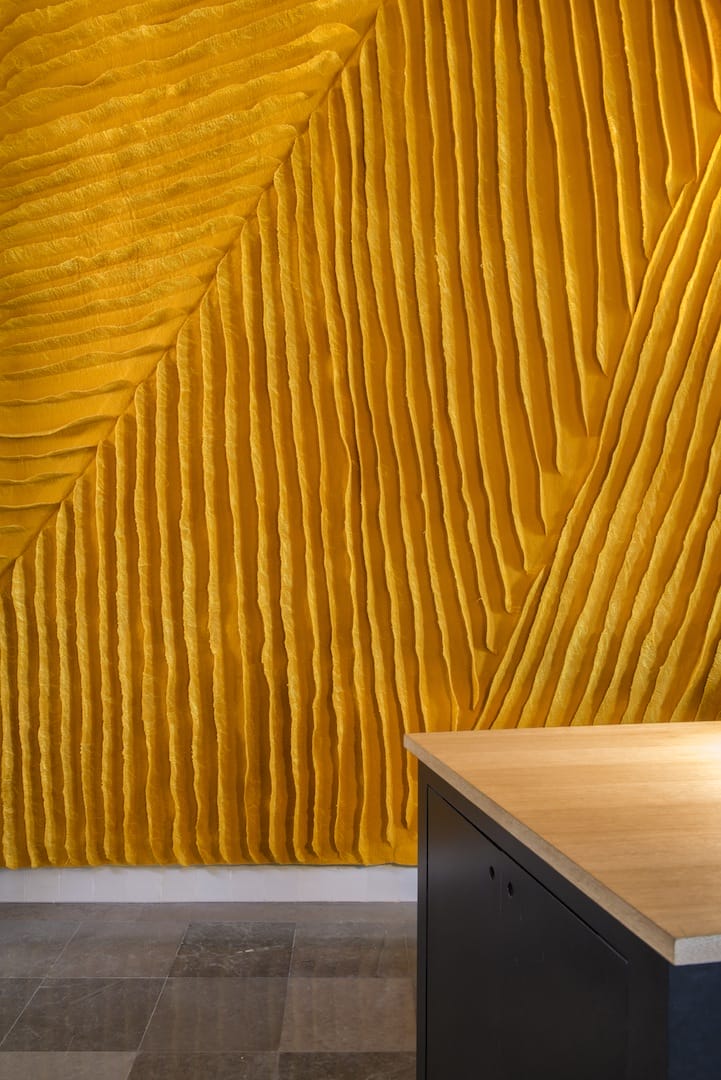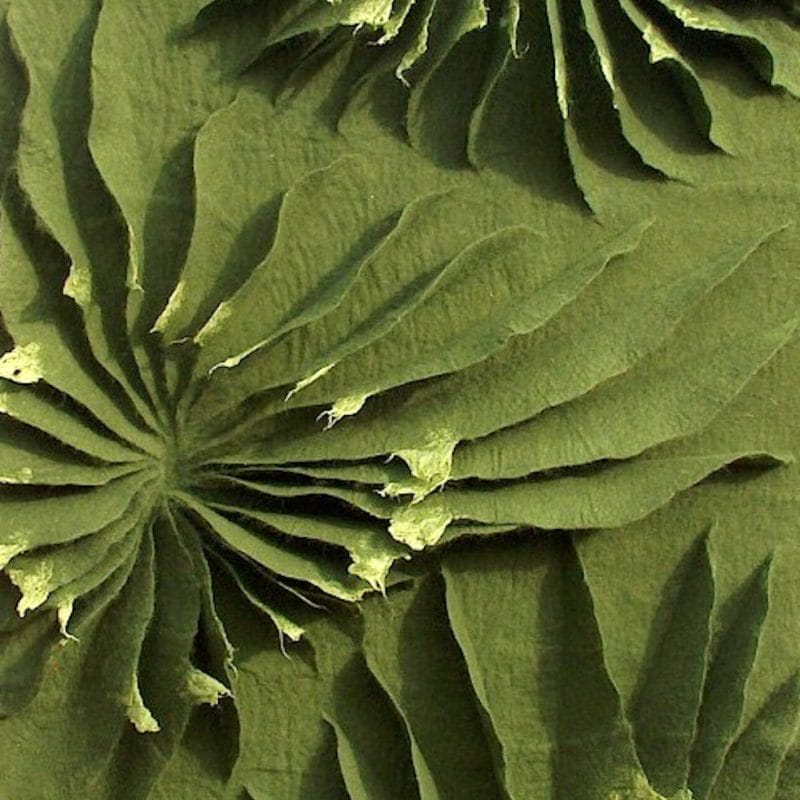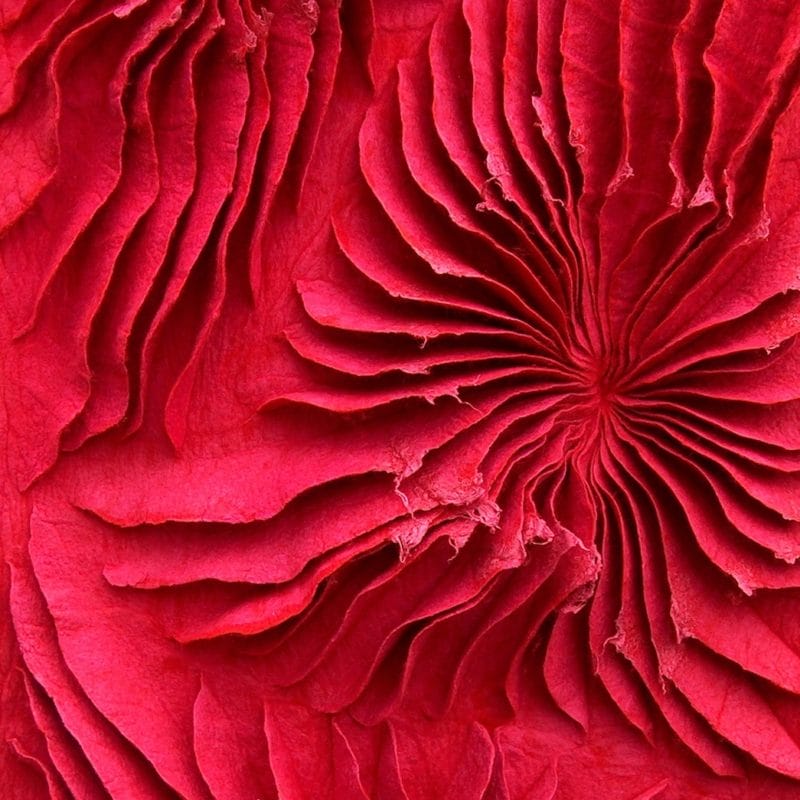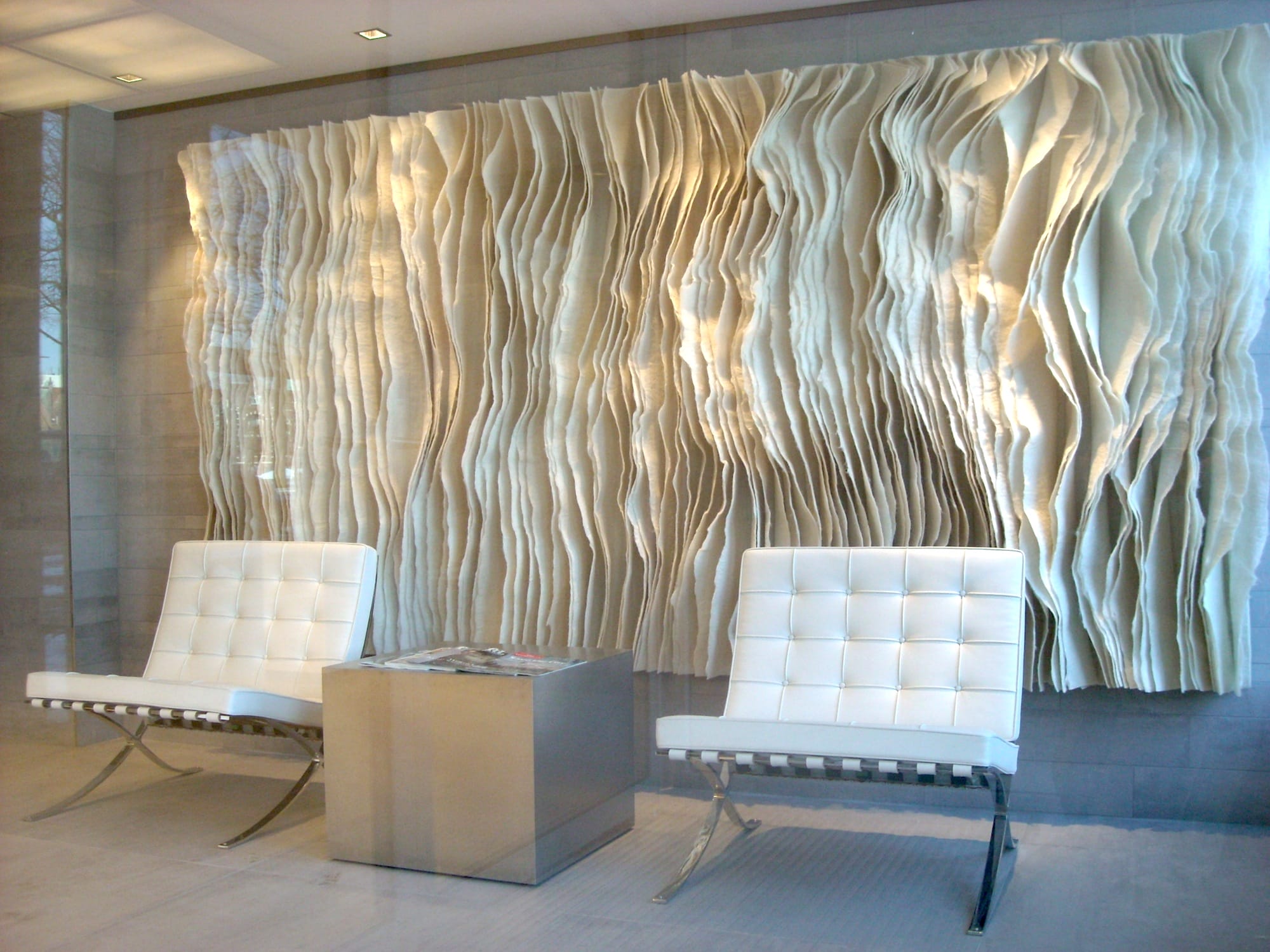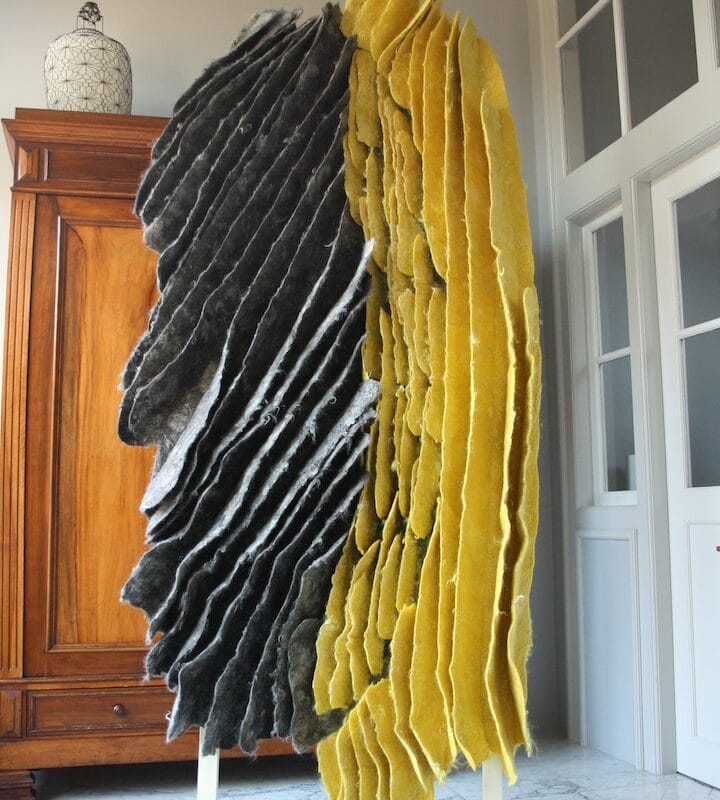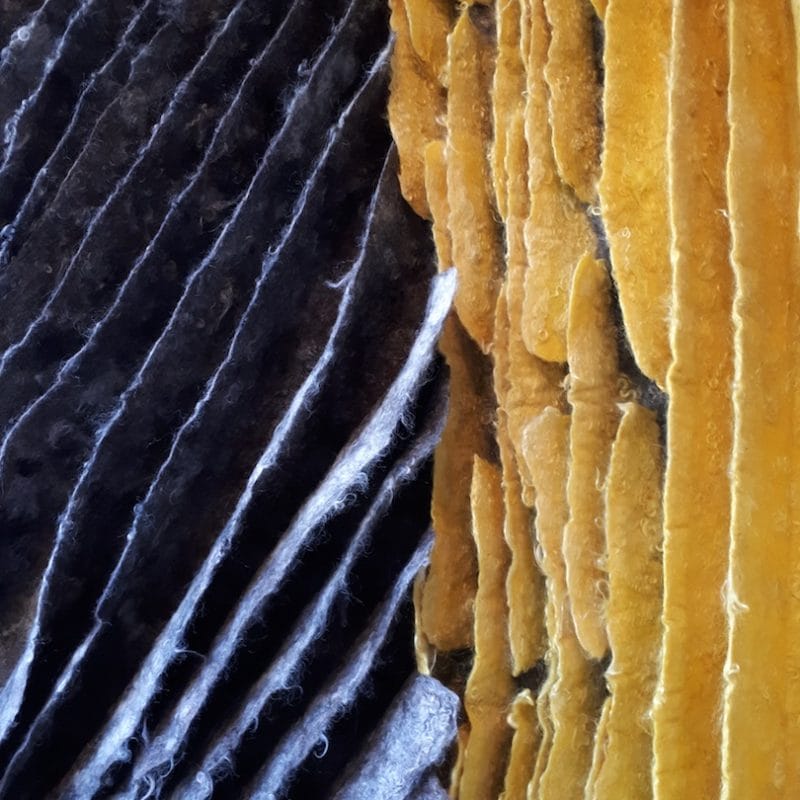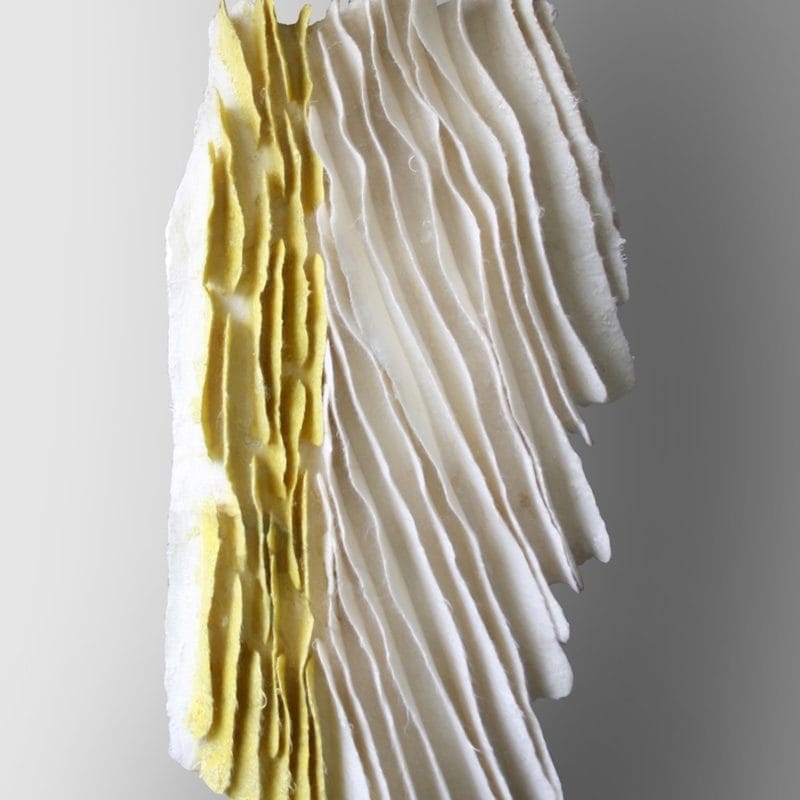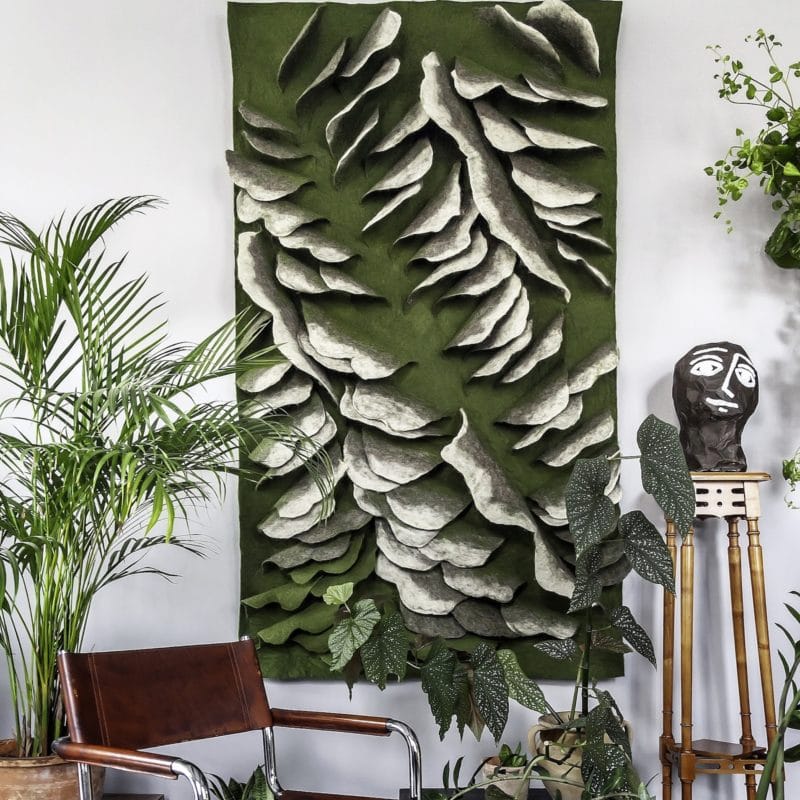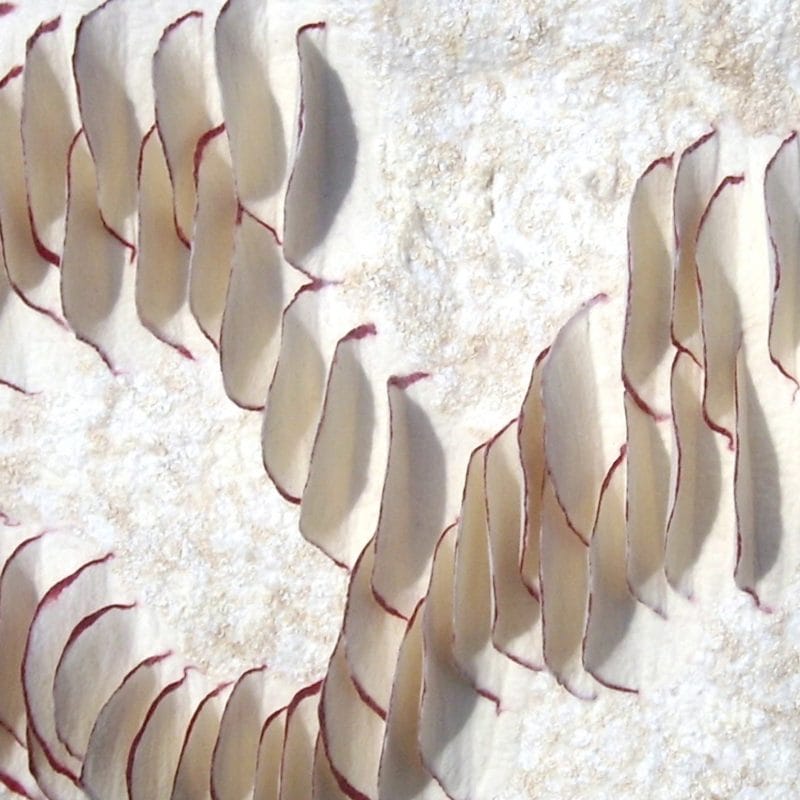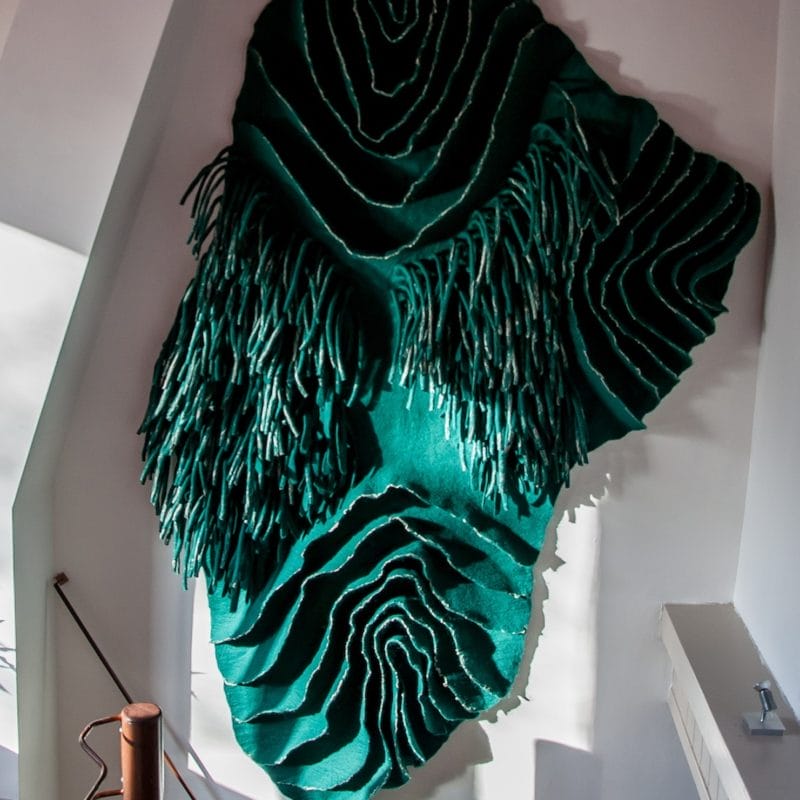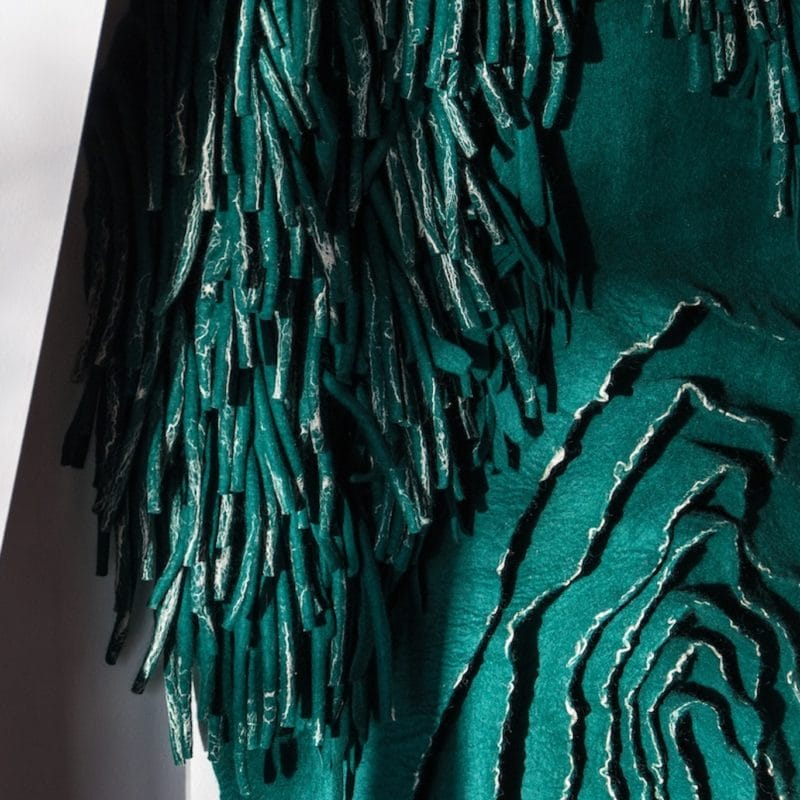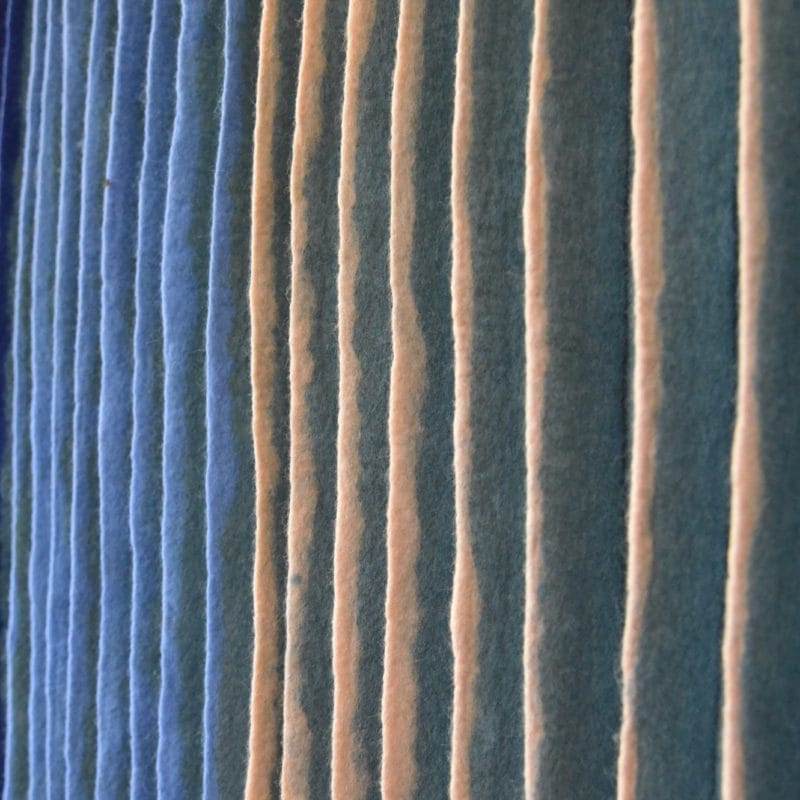Interview with Claudio Varone and Anneke Copier
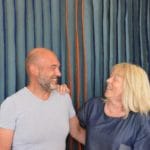
Felt for Architecture is the name by which the textile artists Claudio Varone and Anneke Copier, Claudio architect and interior designer, Anneke felt artist for more than 30 years,are known.
This artistic partnership has led Anneke and Claudio to develop a personal and original aesthetic language that finds in felt, an ancient material and embodiment of the very essence of craftsmanship, its form of maximum expression. From the combination and manual processing of wool, sometimes associated with other natural materials such as silk, cotton and linen, monumental three-dimensional tapestries come to life,inspired by landscapes, colors and shapes of nature.
The works created by Felt For Architecture have been exhibited in Art Galleries and Museums including the Holon Design Museum in Israel, the Meesterlijk in Amsterdam, the Italian Cultural Institute in Amsterdam, the International Fabric Biennial in Belgium and the Salone del Mobile in Milan. Their felt tapestries are also part of numerous public and private collections.
Below is a link to the artists’ website:
https://www.feltforarchitecture.com/
Anneke and Claudio, why did your artistic choice fall on felt as your medium of expression?
Can you tell us something about your personal history as artists?
Claudio: My artistic career linked to textile art began in the 1990s. My research at the time focused on primitive art. Aboriginal and central African painting attracted my attention. I began to paint on unbleached fabrics such as jute and cotton with a very fluid acrylic technique. Human bodies and diversity took shape through a purely graphic representation. When I moved to the Netherlands in 2000, I continued my research and began to include the technique of free embroidery with simple and linear stitches and projecting fibers in my painted works. By chance in 2003, together with a hat designer friend of mine, we took a series of practical lessons on textile modelling techniques organized by a technician from the Academy of Fine Arts in Amsterdam. One of the techniques considered was felt. It was love at first sight. The technique responded to my growing need to work with fabrics in a sculptural way. That’s how I started my path of experimentation with felt and three-dimensionality. In 2003 the project Felt For Architecture was born with the first exhibition of my works in a shop in Amsterdam. Large tapestries hung from the walls and sculptural scarves rested on pedestals to emphasize their three-dimensional nature.
Anneke: Textile always had my interest. So in my spare time I learned spinning and experienced the meditative effect of raw wool. The spinning was followed by weaving.
Until I saw a demonstration of felt making on a textile event.
It fascinated me greatly. The process awaked primal emotions in me. The whole body is part of the process. From that point on, 35 years ago, I learned (almost) everything I have to know about making felt.
It is a sustainable process, and this is very important to me. Wool, soap and water are the ingredients to express myself.
Now I am aware of the many possibilities the felting process can give me, but I still see new challenges.
I was a teacheronce. At the request of colleagues, I could give creative lessons in my specialty. Children from 4 to 16 years learned how to make felt under my leadership. In the meantime, I also gave workshops for adults.
My hobby became an even bigger part of my life through the years. So in 2000 I decided to change my job. I became an artist and opened my studio in 2000.
For years I have made clothes collections: transparent, feminine and smooth.
I have been on shows and events at home and abroad with my ‘wearable art and art to wear’.
Cloths are replaced by ‘the last coat’, a burial shroud for the last journey of a deceased.
In 2006, I started working together with Claudio on ‘Felt For Architecture by Claudio Varone and Anneke Copier’.
When was your two-person project “Felt for Architecture” born, in which you are united in an important artistic partnership?
Claudio: The processing of felt on a large scale is very physically demanding, so the need to seek help for the creation of three-dimensional tapestries immediately emerged. That’s why I came into contact with Anneke Copier in 2006. Her enthusiasm and willingness to collaborate were immediate. At the end of that year we already had our first solo show in Amsterdam under the name of Felt For Architecture by Claudio Varone and Anneke Copier.
Since then we have worked together on the Felt For Architecture project.
Your artworks are the result of an experience of artistic collaboration that began more than ten years ago. What are the advantages and difficulties you encounter in this two-person experience?
Claudio and Anneke: There are many advantages. As already expressed above, the technique we use and above all the scale of our work requires great physical effort. Being two is fundamental. In addition, each work requires slightly different techniques and tricks. Collaboration is expressed through the exchange of opinions and it often happens that what one of us does not see is compensated by the careful gaze of the other. In short, you become complementary. And then in practice we also share tasks. Behind the realization of a piece there are a whole series of different phases to be covered such as the design, the realization of drawings and models in paper, the research of materials on the market, sometimes the dyeing of wool and silk with the use of plants and flowers, the contact with customers, the time planning of projects and the organization of collaborations for the most important projects, and so on.
Like all two-way relationships there are times when you do not share some of the other’s choices, but you still have to look for the way to compromise in order to get to the result you want. This is also a research.
Do you have pre-established roles or competences within the process of designing and producing your felt tapestries, or do you work in synergy without specific roles?
Claudio: when the collaboration was born in 2006 I had a series of notebooks of drawings ready to take shape. On the basis of those drawings we have created many works. Then, over the years, we can say that a series of works were born from ideas in synergy. The phase of realization of the works is always done by four hands and sometimes by 10 hands. Then Anneke often deals with the acquisition of materials and public relations, while I deal mostly with the realization of the projects and their graphic translation.
How did your project for the Dutch Parliament in Den Haagcome about?
Claudio and Anneke: One day architect and restorer Frederik Franken called us on the phone for a new project for the Dutch Senate, we where really exited.
It was the summer of 2011 and, at that time, Franken was responsible for the renovation of few areas of the Parliament building in The Hague, a splendid royal monument and part of the Binnenhof complex, a building which finds his origin in the 14th century.
The entry hall of the Senate had acoustic problems and it was necessary to make an ad hoc intervention, which had to be in line with the esthetic quality of the space, and in line with the style of the Senate room, situated just on the other side of one of the entry walls.
We decided to have brainstorming session with the architect in order to understand the project strategy and to take into consideration all the aspect of it.
A week later we were at the building site, and indeed, acoustics was really bad in this large entry hall with its marble floor, plaster walls and high wooden ceiling. It was necessary to make an intervention on the walls with a material which could improve the quality of sound in this space.
At the time when the big meeting room of the Senate was created, it was common practice to decorate the walls of representative buildings and upper-class residences with the famous Belgian tapestry named Gobelin.
The subjects of the tapestries where pretty much the same: the representation nature’s romantic landscapes, antique ruins and a deep perspective on a faraway horizon. Together with the architect we decided that our research had to start from taking into consideration the Gobelin tradition.
We explored the tapestry’shistory and, through a chronological tour up to the present days, we studied the landscape in the Dutch art history.
Van Gogh with his bright colors and dynamic painting technique created the foundation for our project.
By mutual consent with Architect Franken and following the lines of the three-partitioned wooden ceiling in the entry hall we decided to create 3 hypothetical windows with a view on a modern agricultural Dutch landscape on the large wall behind the reception desk.
Yellow was going to be the color for our felt tapestry. It was perfect with the light coming in from two large windows facing north/west and it was matching well with the existing colors of the space.
It took about one year to realize the project, during which we made several drawings and samples on a 1 to 1 scale.
After a series of meetings the project was approved by the senate commission.
It took us 6 months to realize the final work which consisted of three large handmade felt tapestries of about 15 square meters each, in bright golden yellow.
This monumental work is now hanging in the entry hall of the Senate building with all its powerful brightness and its soft and warm character.
What is, in your opinion, the relationship between art and craftsmanship? How important are these for you, what role do craft techniques play in the creation of your felt works?
Claudio and Anneke: Craftsmanship plays a fundamental role in our work. Thanks to the techniques we have developed over time, we are able to translate our ideas into practice. We are first and foremost craftsmen. We do not give our works to third parties. Everything happens in our workshop in the Dutch countryside. I like to call our work ‘tailoring’.
How do you choose the subjects of your felt tapestries? What do they talk about and what are they inspired by?
Claudio: Everything around us is a source of inspiration.
I am personally bulimic when speaking of images. I take pictures of what I see around me, nature, art of the past and art of today, the city and fashion. Now that we live a very active digital life, the web has become an inexhaustible source of impressions and inspiration. Our work speaks of the joy of living. It must give emotions and above all give visual, tactile, acoustic and olfactorypleasure.
Yes, because natural materials have a smell that I really like. A primitive, archaic scent.
Our works are basically the material translation of the whole emotional world that concerns us, from a positive point of view.
Anneke and Claudio, you make monumental tapestries or large felt works. Can you explain the technical or stylistic reasons for this choice?
Claudio: My work as an architect spontaneously leads me to think in spatial terms. Large dimensions allow me to create works that dialogue with space and become architecture themselves.
The tapestries of the series “New Identity”, you say that: “It explores (or they explore) the multiple realities that arise from the encounter between different identities” Can you explain?
Claudio: We live in a historical moment, where multiculturalism and diversity are sometimes experienced with suspicion. I, as a human migrant, see the mixture of cultures and identities as an opportunity to broaden my horizons and I am convinced that cultural contaminations give life to rich and surprising realities. ‘New Identity’ is born from this kind of considerations and translates them into works where different shapes, signs, colors and structures penetrate and give rise to a new world, new identities
In your felt tapestries, you use wool in combination with other fibers such as silk and linen. As a layperson of these techniques, I ask you to explain to us what kind of study and experimentation activities are behind your work.
Claudio and Anneke: The technique of wool felt is very old. That is why traditional technique is the basis of our work. Then the linguistic need to obtain effects of surfaces and graphic elements lead to experiment the combination of wool with other fibers and materials. On the market you can find many natural fibers, such as silk, linen, bamboo or many varieties of wool and many varieties of fabrics from cotton to linen and silk. Each of these materials processed together with bergschaf wool, (which is the basis of our works as it allows to obtain a felt that can be very sturdy), can give a felt with different material and graphic results, which we use according to the needs of the work itself.
What are the average times of realization of one of your works?
Claudio and Anneke:The processing time varies a lot depending on the size of a work and on the technical complexity. The time can vary from a few days for a small work to many months for important works.
Among the many prestigious projects and works that you have carried out, is there one that has played a decisive or important role for your artistic growth?
Claudio and Anneke:All the works are unique, and therefore play an important role in our growth path. When we venture into a completely new project and technique, it is an opportunity for us to make discoveries in both the formal and technical spheres, while when we create a work that is part of an already existing series, we take the opportunity to refine the techniques of realization and make small variations.
When one decides to buy works made with delicate materials such as textiles, you need to know how to preserve them. What are the storage conditions for a felt tapestry? Does it require a particular or complex “maintenance” to protect it from the damage of time?
Claudio and Anneke:The felt in our works is a very solid and resistant material. Where there are additions with fibers such as silk and linen then the surfaces are slightly more delicate. Wool does not retain dirt, but is sensitive to dust and moths. Maintenance is simple but necessary to preserve the works. It is sufficient to regularly vacuum the dust that deposits on the surface with the help of a common vacuum cleaner, adjusting it to a medium-low power. Moth killing paper should be pinned on the back of the work to protects them from moths of wool. However, we always say to our customers to touch and caress the work, it is a pleasure for the user and the moths will be disturbed.
What are you working on right now?
Claudio and Anneke:We have just presented a new series of works, entitled “Compositions”, at the Design District in Rotterdam, inside the Van Nelle factory, a building belonging to the modern movement.
The research, translated into this series of works, concerns the juxtaposition of different surfaces to create free compositions with a strong geometric character. Each surface is distinguished by its size, shape, structure, color and graphic elements. This research is inspired by the painting and architecture of the Bauahaus period and by figures such as Klee and Gropius.
